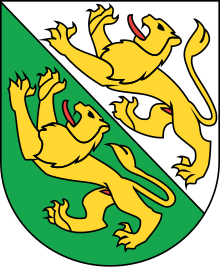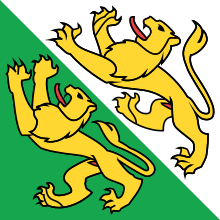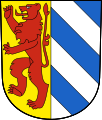Flag and coat of arms of the Canton of Thurgau
The coat of arms of the canton of Thurgau shows two yellow ( heraldic : golden), striding lions on a diagonally divided, white (heraldic: silver) and green background. The lions are taken from the coat of arms of the Landgraviate of Thurgau , which in turn is based on the coat of arms of the Kyburg Count is based. When the coat of arms was created, white was chosen as the color of innocence and green as the color of freedom.
Blazon
The official blazon of the Thurgau coat of arms reads: obliquely divided by silver and green with two red-tongued ornate golden lions .
history
From the Kyburgers

The coat of arms of the canton comes from the coat of arms of the county of Kyburg (11th century to 1264). Representations of the coat of arms on seals have survived from the 13th century (before the Kyburger died out in 1264). In the Zurich coat of arms (around 1340) and Gerold Edlibach (around 1490) the golden lions are depicted on a red background. This is the coat of arms of the Neu-Kyburger (after 1273). The blazon of the Kyburg coat of arms reads: In red a golden sloping bar, accompanied by two striding golden lions .
The importance of the lions probably goes back to the two families from which the county arose, namely from the merger of the two equal aristocratic families of the Lords of Winterthur (Adelheid, the daughter of Adalbert) and those of Dillingen ( Hartmann I. von Dillingen ) .
Habsburg rule
After the Habsburgs took over the county of Kyburg, which was leaderless due to the family's extinction - the last Count of Kyburg, Hartmann IV. , Bequeathed the empire to his nephew, Rudolf I of Habsburg - they granted the city of Winterthur permission to keep their coat of arms in 1275 . In this way, the motifs of the lions and the sloping beam have survived to the present day.
Independent canton 1803
The current canton of Thurgau was from 1460-1798 a so-called common rule of the seven (Zurich, Lucerne, Uri, Schwyz, Unterwalden, Zug and Glarus) or eight ruling (from 1712 together with Bern) as well as the 10 places participating in the maleficent (the named Cities and towns with Freiburg and Solothurn), d. H. the Landgraviate of Thurgau was administered jointly. From 1798–1803, Thurgau was an administrative unit of the Helvetic Republic. It was not until 1803 that the area received sovereignty rights together with other cantons such as St. Gallen and Vaud through the Napoleonic Act of Mediation . At that time, green, previously unpopular in heraldry, was introduced as the color of freedom. The colors white and green are often used in cantons' coats of arms at this time, including in the cantons of Vaud and St. Gallen. Historically, the comparability is certainly greatest with Vaud.
Actually, because of the heraldic rule that two metals in a coat of arms must not meet directly, white and yellow were not allowed to be direct color neighbors. That is why the Thurgau coat of arms is still considered a curiosity today. The attempt made a few decades ago to replace the coat of arms with one that complies with the color rules of heraldry was unsuccessful.
Similar municipal coat of arms
In direct connection with the county of Kyburg
When they were introduced in the first half of the 20th century, the coats of arms listed here were deliberately derived from the coat of arms of the County of Kyburg - with the exception of Diessenhofen, the municipalities are located in the canton of Zurich.
Diessenhofen coat of arms
Coat of arms Andelfingen ZH
Coat of arms Kyburg ZH
Winterthur coat of arms
The concept of village or local coats of arms goes back to the end of the 15th century when the coats of arms of individual bailiwicks or offices were depicted for the first time (mostly based on the coats of arms of long-extinct noble families from the respective area). The Zurich Chronicle by Gerold Edlibach (around 1490, p. 420/1 ) shows the coats of arms of towns and bailiwicks as well as the coats of arms of the parishes on Lake Zurich ( the Kilchhövinen collieries on Lake Zurich ). Edlibach shows the Kyburg coat of arms for the county of Kyburg and already a modification of it as the coat of arms of Andelfingen Castle (the Andelfingen coat of arms near Edlibach shows the lower lion walking downwards, while the modern Andelfingen coat of arms adds a six-pointed star to the lower lion). In the 16th century, village coats of arms appeared more and more on maps and in coats of arms disks ( official disks ). On the Zurich canton map by Jos Murer from 1566, both the Winterthur and Andelfingen coats of arms show as a mirror image of the coat of arms of Kyburg, i.e. with two lions walking to the right (heraldic left).
Derived from the canton's coat of arms
The following coats of arms (selection) are derived from the coat of arms of the Canton of Thurgau and show the red lions taken from the coat of arms of the Landgraviate of Thurgau, often on a white background. The color scheme white / green in the coat of arms of Kesswil is also interesting, because green was frowned upon as the color of the coat of arms until the Helvetic era.
The lion is a generally very popular heraldic animal of the Thurgau villages, see z. B. the coat of arms of Frauenfeld , Wilen TG or Wigoltingen . However, the connection with the Kyburg coat of arms can no longer be precisely proven.
See also
literature
- Louis Mühlemann: coat of arms and flags of Switzerland. 3. Edition. Bühler-Verlag, Lengnau 1991, ISBN 3-9520071-1-0 .
Individual evidence
- ↑ Wiki Genealogy: Thurgau coat of arms, going back to Mühlemann, s. References ( Memento of the original from September 21, 2006 in the Internet Archive ) Info: The archive link has been inserted automatically and has not yet been checked. Please check the original and archive link according to the instructions and then remove this notice.
- ↑ "Herrgott ( Genealogia diplomatica ) provides the images of some Kyburg seals that were found on documents from 1240–1262. [...] Hartmann von Dillingen's seal is preserved on a document from 1220, a shield with horizontal stripes and four lions." Franz Ernst Pipitz, The Counts of Kyburg (1839), 27–30 .
- ^ «This is how the copist of the Kyburg family tree and the Tschudische Wappenbuch describe it. Lord God: Est autem Kyburgensis clypeus coccineus, quem balteus permeat aureus, utrinque comite leone metalli eiusdem . " ["The Kyburg shield is scarlet, crossed by a golden bar, accompanied on both sides by lions in the same metal"] Franz Ernst Pipitz, Die Grafen von Kyburg (1839), p. 28 , fn. 1.
- ↑ page Thurgau the Official Encyclopedia of Arms
- ↑ Markus Zahnd: The «Leuli» is and remains a lion . In: Eastern Switzerland on Sunday . No. 16 , April 19, 2015.








